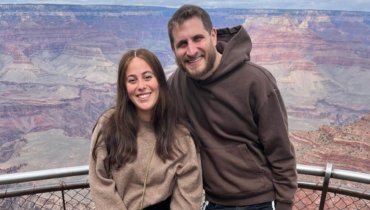This Orthodox Jew Was Drafted To The NBA In 1980
While Ryan Turell is stirring up a lot of excitement for his draft to the G League, NBA’s minor league organization, playing his first game last night, it turns out another Orthodox Jew had already been drafted to the NBA 42 years earlier. In 1980, David Kufeld was the first Orthodox Jew to be drafted to the NBA — for the appropriately titled Portland Trailblazers. Both Turell and Kufeld were leaders on Yeshiva University’s basketball team, the Maccabees. They also both share a fierce determination in the sport.
These are important wins to celebrate. Due to the stringencies of religious observance — such as keeping Shabbos and kashrut — and the necessity for teams and sports institutions to be willing to accommodate those observances in order for Orthodox Jews to participate, it’s difficult for Orthodox Jewish players to even dream. For these reasons, among others, David Kufeld did not intend to sign with the Trailblazers upon being drafted, although that does not diminish the accomplishment. We are perennially asking the question: will there be room for Orthodox Jews in the modern movement for increasing diversity, equity, and inclusion?
At 6’3” by age 13, it seems like a given that David would gravitate toward basketball. That being said, it was actually baseball that was his first love. He used to argue often with the coaches of opposing baseball teams that, yes, he was actually the age he claimed to be! In fifth grade, he gave basketball a try. David jokes that playing basketball helped him come to terms with his height, particularly because it’s always one of the first questions asked of tall people.
He proceeded to make the basketball team in seventh grade at North Shore Hebrew Academy, then played for the varsity team at MTA beginning in freshman year. He says that he was always encouraged to pursue sports — particularly by his parents, who supported him constantly. “It was a bit of a schlep from Great Neck,” David says about his education at MTA. “I probably didn’t appreciate it, then, the many hours my dad spent after a long day in the office to schlep up to Washington Heights at least twice a week to pick me up.” He spent many hours practicing in the driveway, admittedly more than he spent time studying.
Intent on playing college basketball, he then attended Yeshiva University. It was (and remains) admittedly difficult to play at any other institution if one is Shomer Shabbat, but David was happy there — even though he played during the “lean years” for basketball at YU. “We had no gym,” he recounts. “We had a hard time getting enough players — which you need for practice and scrimmage.” David also contrasts the games of his youth to the present in terms of the fanbase. “We played in what you’d call radio silence,” he explains, unlike today when the YU Macs have thousands of fans, many of whom watch games remotely. Still, he greatly enjoyed his time at YU, and gives tremendous credit to his coach, Dr. Jonathan Halpert, who not only knew the game well but was a fantastic mentor to whom David remains close to to this day.
With the lack of resources and public following, as well as YU’s status as a Division III institution, David’s draft to the NBA is even more impressive. He modestly explains that his personal statistics were very high: he led the nation in rebounding for two years. He’d also taken care to cultivate his reputation since he set his sights on pro-basketball “only” in college, rather than high school.
Self-promotion meshed very well with his field of study at the college. Majoring in public relations and advertising, David integrated sports and education by taking on the PR for all the school’s sports teams. With those skills, he also put together a self-promo packet, which he sent to ten NBA teams.
In 1980, the NBA draft was not a spectator sport, nor was it updated minute by minute on the internet. So, it took until the day after the draft — his father enthusiastically calling the YU dorm after reading the morning paper — for David to find out that he’d been drafted by the Portland Trailblazers.
Although he attended “rookie camp” along with the other drafted players, David did not believe that he would be selected at the end of the process. One of the reasons he cites is that 6’8”, his adult height, is considered short in the NBA, which meant that he would not be playing center as he had been at YU. However, he also didn’t intend on signing with the Trailblazers due to the lack of accommodations for his lifestyle as an Orthodox Jew. Further, he also wanted to play basketball in Israel the following year, despite the NBA’s attention.
David did indeed play in Israel that year, although not according to plan. Initially, he thought he’d be playing for Elitzur Tel Aviv, which, due to being an outgrowth of the National Religious Party, meant that he would not have any sort of difficulty regarding Shabbat observance. However, due to having frozen the team standings that year and subsequent budget cuts for foreign players, Eliztur did not sign him on. He instead played for Maccabi Ironi Ramat Gan – who actually allowed him to be their designated foreign player (a position usually reserved for foreign gentiles) due to not having made aliyah yet!
The fact of the matter is that the world of sports has historically not been accommodating to players of faith, in general. David points out that Muslim athletes have had to compete on Ramadan, Jews who are shomer Shabbat need to take that into account, and there are many non-recognized religious holidays that affect sports schedules. “It’s not a level playing field,” he jokes. “Sports is about how good you are — there is a meritocracy, but on the same token, one’s religious observance should not preclude you from being given a chance to succeed or fail.” Ultimately, the choice to progress or stop one’s career in sports is that of the player, but it’s a difficult decision to make — and made even more so when in the spotlight.
If you found this content meaningful and want to help further our mission through our Keter, Makom, and Tikun branches, please consider becoming a Change Maker today.







